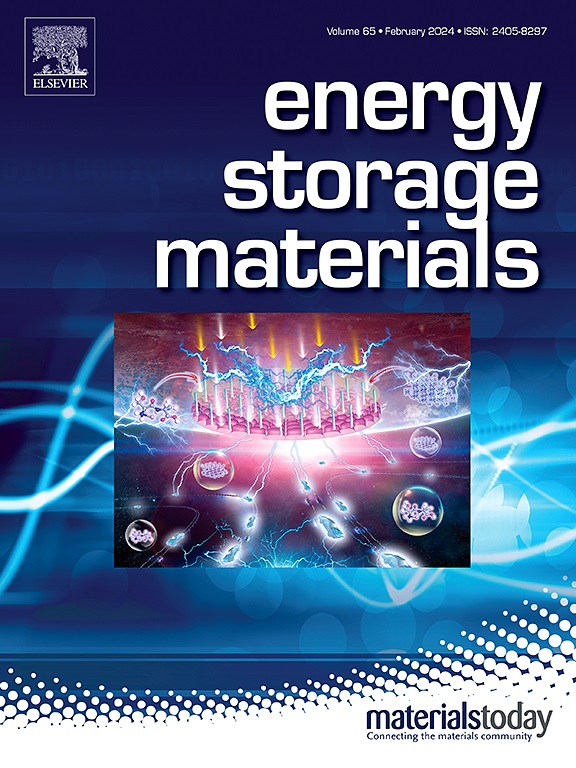Three birds with one stone: Reducing gases manipulate surface reconstruction of Li-rich Mn-based oxide cathodes for high-energy lithium-ion batteries
IF 18.9
1区 材料科学
Q1 CHEMISTRY, PHYSICAL
引用次数: 0
Abstract
Energy storage through additional anionic redox can deliver ultrahigh specific capacities of Lithium-rich manganese-based oxides cathode materials (LRMO). The commercial application of LRMO is hampered by several drawbacks, including structure degradation, continuous capacity and voltage decay, sluggish kinetics and severe irreversible oxygen release, stemming from generation of O2n− (0 ≤ n < 2) species during deep oxidation. Notably, relying solely on a single modification strategy only partially address the problems of LRMO materials. Herein, one-step phosphatizing-assisted interface engineering strategy was successfully implemented, simultaneously fabricating oxygen vacancies, spinel-like structure and an ionic conductor Li3PO4 capping layer on the surface. Among them, the formation of oxygen vacancies is accompanied by the production of a spinel phase buffer layer, which inhibits the generation of O–O dimers and oxygen loss, contributing to the stability and reversibility of anionic redox reactions. The lithium ions conductive protective layer of Li3PO4 accelerates Li+ diffusion rate while suppressing harmful interfacial side-reactions between the electrode and electrolyte. More importantly, the incorporation of P into the subsurface lattice regulates the local electron configuration and activates oxygen redox. As a result, the modification LRMO demonstrates an impressive reversible capacity of 312.9 mAh g−1, with excellent capacity retention of 91.87 % at 1 C and 82.43 % at 2 C after 500 cycles, respectively. The mult-ianionic redox mechanism provides an effective and straightforward method to stabilizing LRMO for next-generation high-energy lithium-ion batteries.
一石三鸟:还原气体操纵高能锂离子电池富锂锰基氧化物阴极的表面重建
通过额外的阴离子氧化还原储能可以提供超高比容量的富锂锰基氧化物正极材料(LRMO)。由于O2n−(0≤n <)的生成,LRMO的结构退化、容量和电压持续衰减、动力学迟缓和严重的不可逆氧释放,阻碍了LRMO的商业应用;2)深度氧化过程中的物种。值得注意的是,仅仅依靠单一的修改策略只能部分解决LRMO材料的问题。在此基础上,成功地实现了一步磷化辅助界面工程策略,同时在表面制备了氧空位、尖晶石样结构和离子导体Li3PO4覆盖层。其中,氧空位的形成伴随着尖晶石相缓冲层的生成,抑制了O-O二聚体的生成和氧的损失,有利于阴离子氧化还原反应的稳定性和可逆性。Li3PO4的锂离子导电保护层加速了Li+的扩散速率,同时抑制了电极与电解质之间的有害界面副反应。更重要的是,P与亚表面晶格的结合调节了局部电子构型并激活了氧氧化还原。结果表明,改性LRMO的可逆容量为312.9 mAh g−1,循环500次后,在1℃和2℃下的容量保持率分别为91.87%和82.43%。多离子氧化还原机制为稳定下一代高能锂离子电池的LRMO提供了一种有效而直接的方法。
本文章由计算机程序翻译,如有差异,请以英文原文为准。
求助全文
约1分钟内获得全文
求助全文
来源期刊

Energy Storage Materials
Materials Science-General Materials Science
CiteScore
33.00
自引率
5.90%
发文量
652
审稿时长
27 days
期刊介绍:
Energy Storage Materials is a global interdisciplinary journal dedicated to sharing scientific and technological advancements in materials and devices for advanced energy storage and related energy conversion, such as in metal-O2 batteries. The journal features comprehensive research articles, including full papers and short communications, as well as authoritative feature articles and reviews by leading experts in the field.
Energy Storage Materials covers a wide range of topics, including the synthesis, fabrication, structure, properties, performance, and technological applications of energy storage materials. Additionally, the journal explores strategies, policies, and developments in the field of energy storage materials and devices for sustainable energy.
Published papers are selected based on their scientific and technological significance, their ability to provide valuable new knowledge, and their relevance to the international research community.
 求助内容:
求助内容: 应助结果提醒方式:
应助结果提醒方式:


